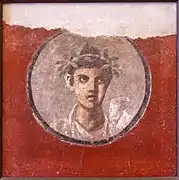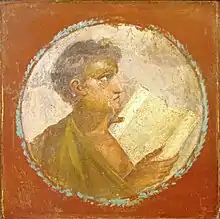Rotulus
A rotulus (plural rotuli) or rotula (pl. rotulae) is a kind of roll consisting of a long and narrow strip of writing material, historically papyrus or parchment, that is wound around a wooden axle or rod and is written on its interior face or side[1] such that it is unwound vertically so that the writing runs parallel to the rod,[2] unlike the other kind of roll, namely the "scroll", whose writing runs perpendicular to the rod in multiple columns.


Roman portraiture frescos from Pompeii, 1st century AD, depicting two different men wearing laurel wreaths, one holding the rotulus, the other a volumen

Rotuli were historically used for:
- Specific legal records in Europe, from which is still derived the title of the judicial functionary denominated the "Master of the Rolls", and the Byzantine Empire;[3]
- Liturgical manuscripts, e.g., those used for chanting the Exultet; and
- Especially mortuary rolls, i.e., documents memorializing the names of all the deceased members of a monastery or other institution, which were banded together and circulated so that they could mutually pray for the repose of each other's decedents.[3]
References
- Grout, James. "Scroll and Codex". Encyclopaedia Romana.
- "What's On?: From Roll to Codex". Bodleian Libraries. University of Oxford.
- Daly, Lloyd W. (1973). "Rotuli: Liturgy Rolls and Formal Documents". Greek, Roman and Byzantine Studies. Duke University. 14 (3).
- Attribution
 This article incorporates text from a publication now in the public domain: Herbermann, Charles, ed. (1913). "Rotuli". Catholic Encyclopedia. New York: Robert Appleton Company. The entry cites:
This article incorporates text from a publication now in the public domain: Herbermann, Charles, ed. (1913). "Rotuli". Catholic Encyclopedia. New York: Robert Appleton Company. The entry cites:
- Léopold Victor Delisle, Rouleaux des morts du IX au XV siecle (Paris, 1866);
- ____, in Bibl. de l'ecole des Chartes, series II, vol. III; Sur l'usage de prier pour les morts;
- Thurston, A Mediaeval Mortuary-card in The Month (London, Dec., 1896);
- Nichols in Mem. Archaeolog. Institute (Norwich, 1847);
- Molinier, Obituaires français au moyen-âge (Paris, 1886);
- Ebner, Gebetsverbruderungen (Freiburg, 1891);
- Wattenbach, Schriftwesen im Mittelalter (3rd ed., Leipzig), 150-74.
This article is issued from Wikipedia. The text is licensed under Creative Commons - Attribution - Sharealike. Additional terms may apply for the media files.